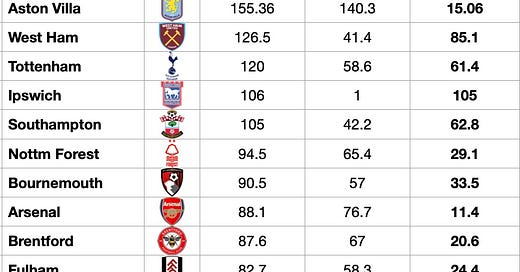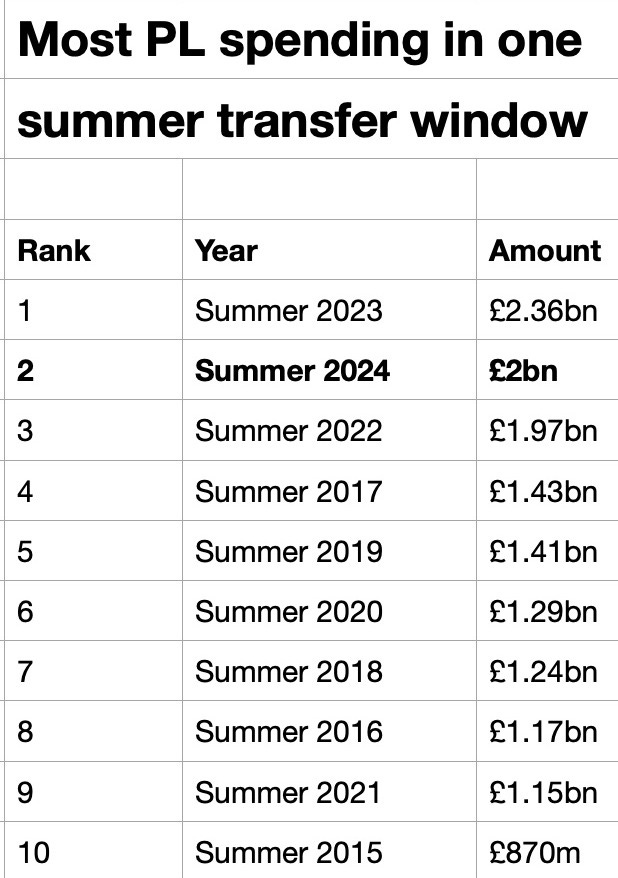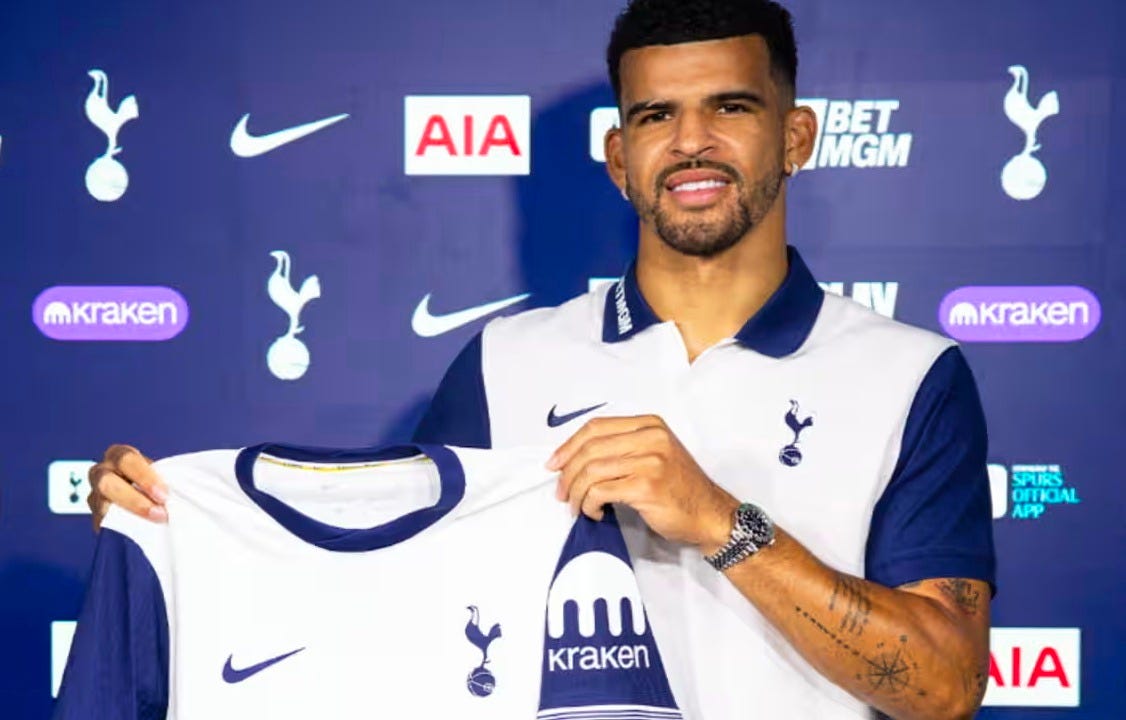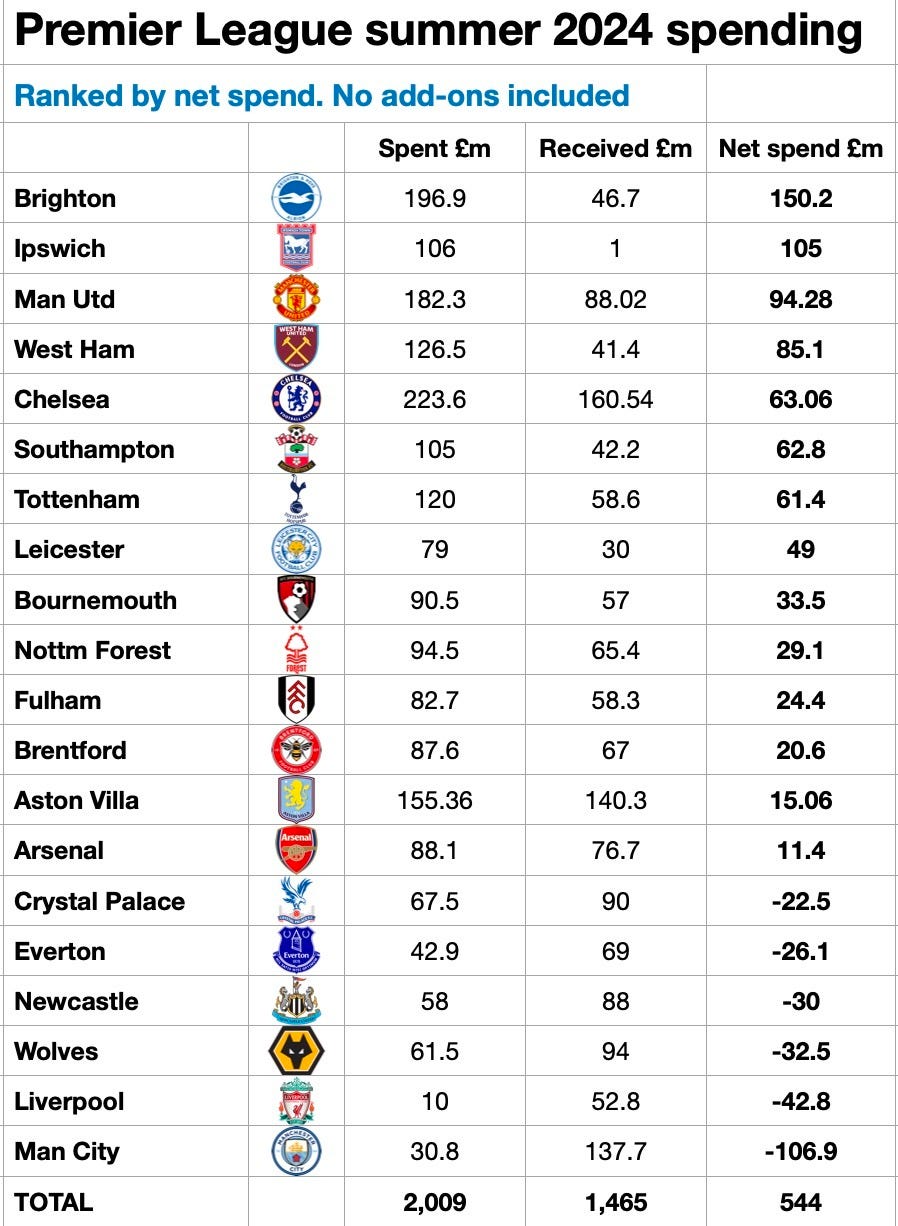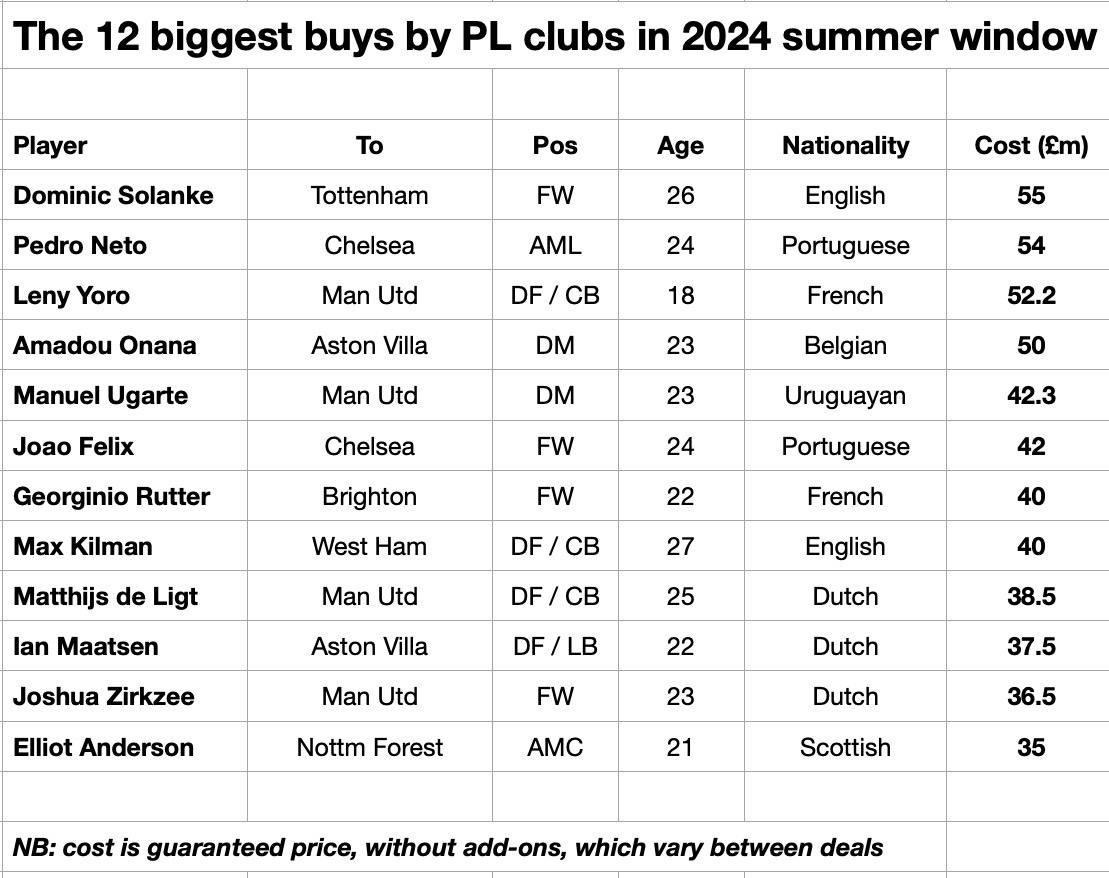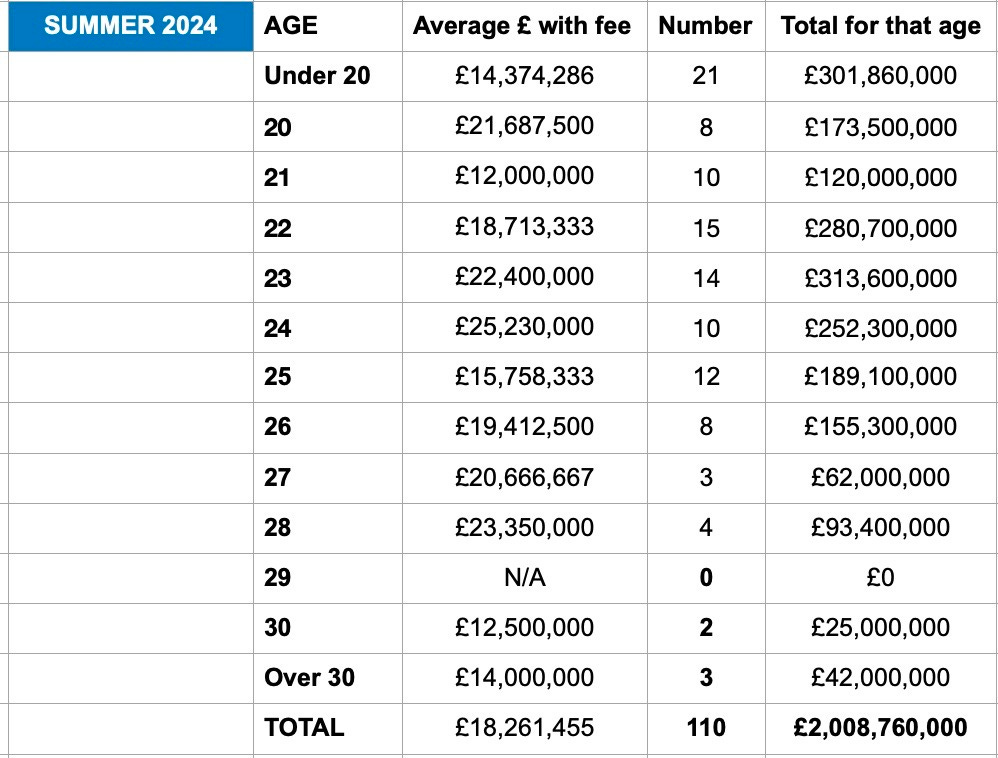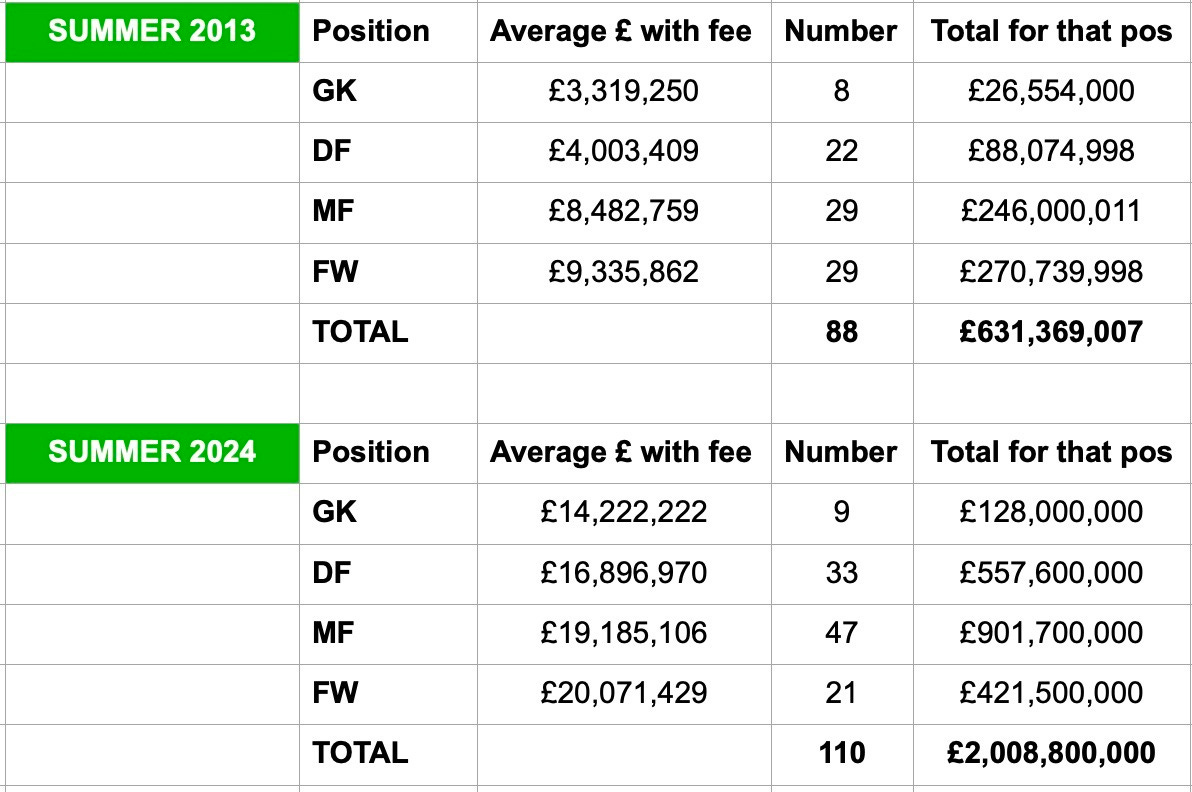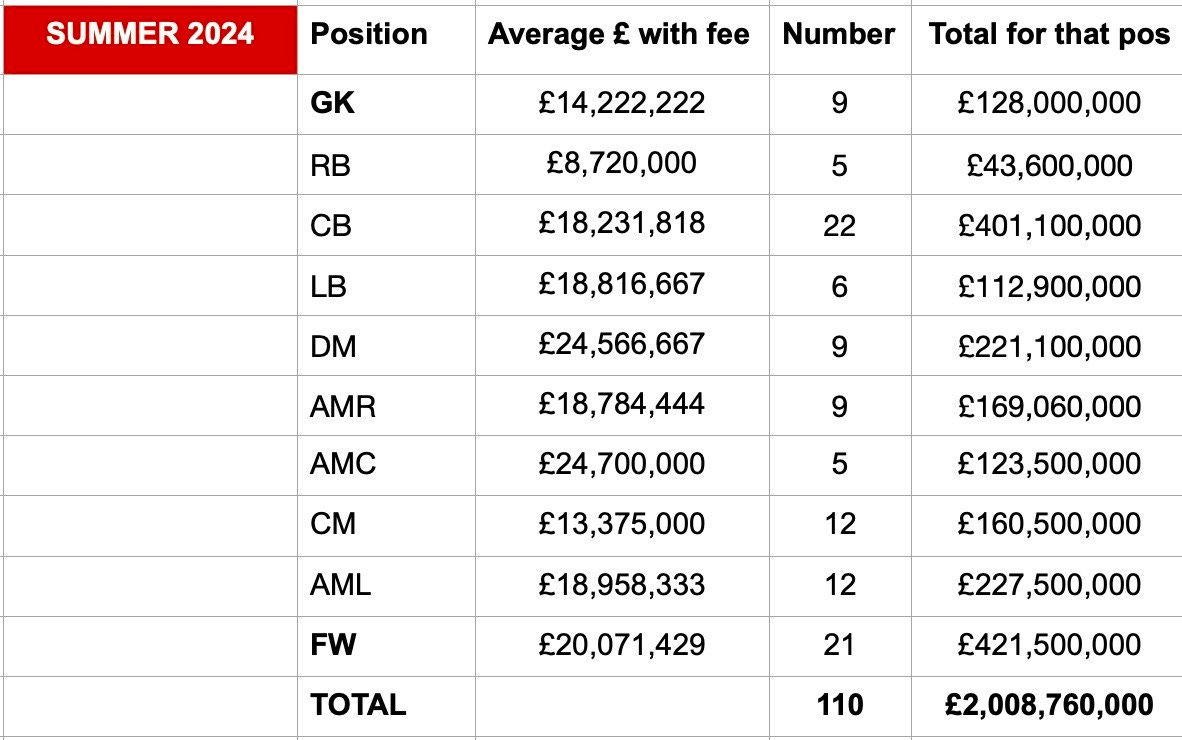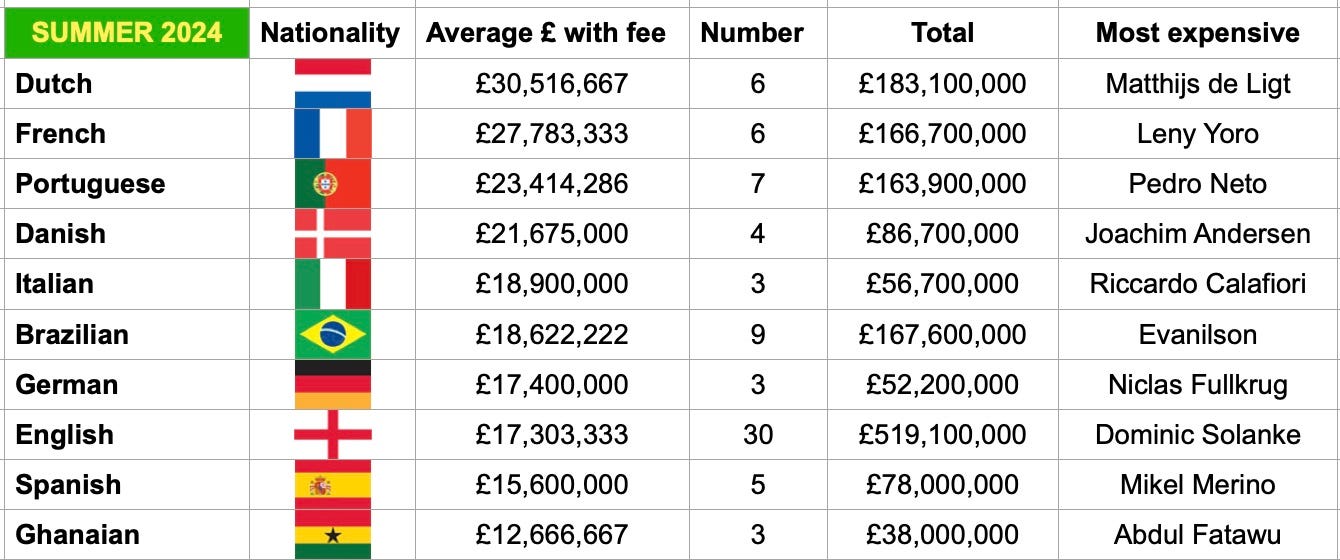Number-crunched: what Premier League summer transfers tell us about the game
Who are the surprise kings of net spend? Which European clubs are the chief importers of Premier League talent? Striker inflation has gone - but why?
The 20 Premier League clubs spent £2.009 billion, gross, on new players in the window that closed on Friday - the second biggest summer spend on record.
The January window was a bust as clubs were gripped by fears they could be sanctioned for overspending, as Everton and Nottingham Forest both were.
There were concerns the summer window would also see a spending slump among England’s elite teams, but those worries were mostly ill-founded.
Today I’m going to analyse the 2024 summer spending by club, exploring who spent most, and least, and who earned most and least from sales. I’ll detail average prices paid for players depending on position, age and nationality and what that tells us about the evolution of the game.
I undertook a similarly in-depth number-crunch of deals at the end of the 2013 summer window, which you can read here.
Back then, there was a clear demarcation in the pecking order of prices paid for players: goalkeepers were cheapest as a cohort, averaging £3.3m when a fee was paid, with defenders slightly more expensive at £4m on average, with midfielders averaging £6.8m and strikers not massively more expensive at £7.3m on average. Things have changed hugely, as we’ll see shortly.
Methodological notes
When compiling this summer’s figures I have made every effort to source the most reliable numbers available, ideally from the clubs involved or stock market statements and other official resources.
Websites such as Transfermarkt can provide a decent general guide but they report fees only in euros and don’t declare exchange rates used; and in some deals they appear to include add-ons, in others they don’t. Some of their figures, albeit a minority, are clearly wrong. For example they say Riccardo Calafiori cost Arsenal €45m when in fact he cost €40m (£33.7m) plus add-ons. Being 12.5% wrong will distort matters somewhat.
My figures include guaranteed transfer fees only, not potential add-ons, which are only ever conditional by nature.
So, for example, Dominic Solanke (below) moved from Bournemouth to Tottenham for a guaranteed £55m, with a further £10m in possible add-ons. So his move is counted as £55m of spending.
Aaron Ramsdale moved from Arsenal for £18m guaranteed, with another £1m being paid by the Saints if they survive in the Premier League this season, and a further £6m depending on future appearances and performance targets.
Manchester United signed teenager Leny Yoro for a guaranteed €62m (euros), or £52.2m, which is the figure I count, but United could end up paying another €8m in add-ons. You get the picture.
Chelsea: kings of gross spending again
With all this in mind, you can see from the table below that Chelsea had the highest gross spending this summer at £223.6m, as Liverpool had the lowest (at £10m), followed by Manchester City with the second lowest spending (£30.8m). No fewer than eight clubs spent £100m or more, gross, while 17 of 20 spent at least £58m.
You don’t need me to explain in words what you can see for yourself from the numbers below but it is worth noting that five of the lowest seven gross spenders (Everton, Newcastle, Wolves, Palace and Leicester) are among those cited with having recent or current concerns about falling foul of the Premier League’s profit and sustainability rules (PSRs).
A quick quiz before you study the next table or start the next paragraph. Which two clubs do you think had the highest net spending this summer?
Yes, you got it. Brighton and Ipswich of course, with net spends respectively of £150.2m and £105m. Only seven clubs had a net spend of more than £50m.
Notable in this table is that Chelsea sold £160.54m worth of players, and Aston Villa £140.3m, both offsetting their huge gross spending to some extent. Manchester City meanwhile, made a profit of £106.9m on summer trading, the most by far of any PL club.
Considering the dozen biggest fees paid for players moving to Premier League clubs this summer, Solanke is at No1 with his £55m guaranteed fee.
These 12 most expensive players of the summer comprise two English players, two Portuguese, two French, three Dutch, a Belgian, a Uruguayan and Scot, the last being Elliot Anderson, born in England but who, so far, has represented Scotland at age groups up to Under-21.
These top dozen players arrived at their new clubs at an average cost of £43.6m and with an average age of about 23 and a half.
Considering a breakdown by age of players signed by Premier League clubs, the single age attracting the highest fees on average was 24-year-olds, who cost an average of £25.23m each, and there were 10 players in that group.
Note that the players being considered in this analysis are the 110 players who made permanent moves (not loans) to Premier League clubs this summer, for fees (free moves are not included).
There are several notable changes from a decade ago in the age groups attracting most money. The 24-year-olds moving in summer 2013 were “only” the second most expensive, behind “peak age” 28-year-olds.
There were 16 players aged 30 or older moving for fees to PL clubs in summer 2013 - albeit not for big fees - whereas only five players aged above 28 moved permanently to PL clubs for fees this summer.
No fewer than 78 of the 110 players moving this summer were 24 or younger.
The penny has dropped: players in ALL positions are valuable
Arguably the single most striking difference between summer PL trading in 2013 and purchases in 2024 is a significant “levelling up” of prices paid across different positions.
Goalkeepers were generally always the cheapest players, followed by defenders, midfielders and forwards, as detailed near the top of this piece.
While that just about remains the case, goalkeepers (as a cohort) in 2024 now cost as much as two-thirds the price of a forward (or £14m on average against £20m), whereas a decade ago they cost just a third.
Back in summer 2013, midfielders were more than 100% pricier than defenders, on average, and now they’re only about 13% more expensive (£19.1m versus £16.9m). Forwards in 2013 were more than double the price of defenders and are now only about about 18% more expensive.
It’s almost as if there has been a realisation that footballers in all positions on the pitch are valuable and play a significant role. “Striker inflation” has largely gone as other key positions have become more valued.
For the 2024 window, I have considered positions in a more granular way, considering both the full-back positions and centre-back prices separately, and also pricing the specific role of defensive midfielder (separate from central midfielders, and also from attacking midfielders), as well as wide attacking players on each flank, with strikers - the more orthodox centre-forwards - in their own group.
Several things jump out to me. First, that the DM and the AMC players (central attacking midfielders, the creatives) are the most valued roles, on average costing around £24.5m each this summer.
Second, that there is really not a huge variance in the average prices of most of the other positions, with centre-backs, left-backs, attacking players on both flanks and centre-forwards all costing on average in the region of £18m to £20m.
Third, right-backs are relatively cheap (because there are more good options available, so prices are competitive?), while central midfielders who specialise neither as DMs or AMCs are also cheaper (for the same reason?).
Dutch and French: premium brands
Below are the average fees paid by Premier League clubs in summer 2024 depending on the nationality of the players being signed. I’ve included all nationalities where three or more players were bought.
English players, 30 of them, had an average price tag of £17.3m whereas - this summer at least - Dutch players (average cost £30.5m) and French players (£27.8m) came at a premium. Also notable is that the biggest number of players moving to PL clubs from any one country bar England was the Brazilian cohort of nine players, at an average of £18.6m.
Cluster clubs: multiple deals with the PL in summer 2024
I’ve picked out six clubs either in England (outside the PL) or in Europe that did multiple deals with Premier League clubs this summer. Burnley, Juventus and Leeds each lost four players to PL clubs, and I’m sure fans of those clubs will either feel aggrieved at being weakened or grateful for cash they received to stabilise their finances.
Scott Parker’s Burnley sold Arijanet Muric to Ipswich (for £10m), Wilson Odobert to Spurs (£31.5m), Sander Berge to Fulham (£20m) and Dara O'Shea to Ipswich (£12m)
Thiago Motta’s Juventus sold Federico Chiesa to Liverpool for £10m, sold Samuel Iling-Junior and Enzo Barrenechea to Villa for approaching £19m combined (while buying Douglas Luiz from Villa for £42.4m), and sold Dean Huijsen to Bournemouth for £12.8m,
Leeds supporters will probably feel most miserable after the sales of Georginio Rutter (£40m) to Brighton, Archie Gray to Spurs (£25m), Crysencio Summerville to West Ham (£25m) and Luis Sinisterra to Bournemouth (£20m), but at least they earned £110m from those deals.
Major recruiters this summer from the Premier League included Lyon, Bayern Munich and Napoli.
Lyon spent almost £60m combined on four players from PL clubs: Moussa Niakhate and Orel Mangala from Forest, Said Benrahma from West Ham and Duje Caleta-Car from Southampton.
Vincent Kompany’s Bayern Munich spent more than £90m combined on Michael Olise from Crystal Palace, Joao Paulinha from Fulham and Eric Dier from Tottenham.
And Antonio Conte’s Napoli spent the thick end of £70m combined on Romelu Lukaku from Chelsea, Scott McTominay from Manchester United and Billy Gilmour from Brighton.
Thanks as ever for reading. This article is free for everyone but the ongoing work on this site will only continue to be possible with the financial support of paying subscribers. Upcoming pieces will include an update on the Manchester City “115” case and a series on the implications of “The Never Ending Season”, domestically and internationally, which is where we appear to be already in elite football.


